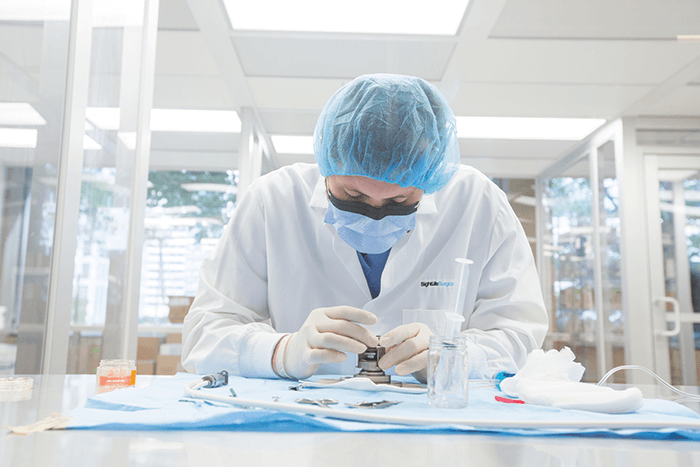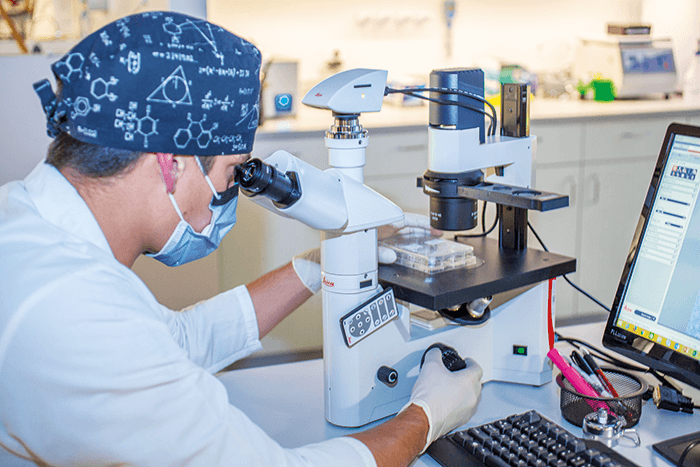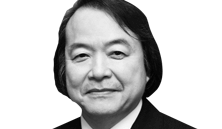
I first began collaborating with Shigeru in 1997. We met at an ophthalmology meeting and were discussing the need for corneal tissue in Japan. Since then, we’ve been providing Shigeru with tissue at the Kyoto Prefectural University of Medicine and the other Kyoto institutes where he performs corneal transplantation. Over time, our relationship has grown. When starting his endothelial cell therapy research, Shigeru needed to secure a long-term commitment from an eye bank to provide him with enough research tissue to be eligible for a grant he was seeking. So around 15 years ago we formalized our commitment and we are proud to continue supporting his research. It was thrilling to announce earlier this year that we are working with Shigeru to bring his groundbreaking endothelial cell therapy to the US. So far, 35 patients in Japan have received injections of cultured donor endothelial cells (See Box – Regenerating the Ocular Surface with Cultivated Endothelial Cell Therapy). Approximately one-third of these received their initial injections over two years ago and have gone on to have fantastic results: no complications, nor instances of graft rejection or infection – all issues that would be considered normal with corneal transplants. It’s an incredible achievement and it’s been inspiring to see such great results because there are so many patients who are not getting the treatment they need. The math just doesn’t add up: across the world, there are more than 10 million individuals with treatable corneal blindness, but only 150,000 corneal transplants are performed per year – partly because there is not enough donor tissue. With cultivated endothelial cell therapy, one donor cornea could reach so many more patients – upwards of 100. It has the potential to reach millions of people who are waiting for a sight-restoring treatment, and my ultimate hope is to one day eliminate all endothelial-related corneal blindness across the globe.
- Corneal endothelial cells derived from allogeneic donor cornea are multiplied through culturing under specific conditions in a specialized culture medium – the “secret sauce” as Monty puts it.
- Whilst the precise components of the medium are protected by intellectual property, a key ingredient is a proprietary Rho-associated protein kinase (ROCK) inhibitor.
- Work by Shigeru and his team has identified that a specific subpopulation of cultured corneal endothelial cells are the most suitable “effector” cell population for clinical application in the anterior chamber (1). They have also identified that to maximize the proportion of effector cells – for a homogenous population of cultured corneal endothelial cells, the preferred donor age is <29 years and a continuous presence of ROCK inhibitor Y27632 is required (1).
- The cultivated cells are injected into the anterior chamber where they can reconstruct and regenerate the ocular surface.
- The therapy could potentially treat many corneal endothelial disorders such as Fuchs’ dystrophy, penetrating bullous keratopathy and post-surgical corneal dysfunction.
We’ve completed the first step in our journey, which was to replicate the cell processing and set up a facility in the US. The next step is to demonstrate that we can transfer Shigeru’s clinical results from Japan, and we hope to begin clinical studies in 2018. Although we’ve succeeded in setting up the facility, the process has not been trivial – there have been many challenges and surprises along the way! One of the main challenges has been the language barrier; all the protocols and instructions were in Japanese and the translations were not always perfect, especially with technical and scientific terminology. We had to work together very closely to verify that our translations were correct. Another was that reading the protocol was not enough. Cell culture is a very precise technical process, so there were techniques that had to be transferred through face-to-face training with Shigeru and his team. Finally, the challenges of taking something from the academic environment and bringing it to a commercial environment, including the preparations for FDA and other regulatory approvals, has been much more complicated than both Shigeru and I anticipated. We thought transitioning the science would be the hardest part, but right now, transitioning the treatment from academic research to commercialization is equally – if not more – challenging.


Collaboration has been so important, and throughout the whole process we’ve been in constant communication and have made multiple trips between the US and Japan to ensure that we were all on the same page. Perhaps the most important aspect of our collaboration has been the ability to bring cornea-related academic research from “bench to bedside” – an ability that has been lacking in the cornea ecosystem. There has been a lot of research on the cornea, but the market has never been big enough to try and drive the innovation and commercialization that you see in other fields, such as cataract. But if corneal research performed in academic institutions is not reaching and benefitting patients, it lessens the value of that research. It’s why having a bridge between academia and industry is critical; it helps realize the purpose of all the hard work. Shigeru began his research with the vision of providing corneal blind individuals access to a better treatment. Without commercialization of his treatment, that would never happen. And the importance of having a commercial entity such as ours dedicated to the cornea space is highlighted in the ability to develop this treatment for the corneal blind. We’re pleased to be part of this vital collaboration to reach the people in need around the world and provide them with a treatment that could safely restore their sight. We simply could not have done this as a nonprofit organization.
Monty Montoya President and CEO of SightLife Surgical, Seattle, USA Monty is CEO of SightLife Surgical, and the former CEO of its nonprofit parent company SightLife. He joined SightLife in 1997, and has since been dedicated to transforming the cornea ecosystem by driving innovations in research, products, prevention and policy. He has been honored with prestigious awards for his vision and service, including the Ernst & Young 2014 Entrepreneur of the Year Award in the Pacific Northwest Life Sciences category and the Eye Bank Association of America’s coveted Heise Award, which is given to a non-medical individual who has made the greatest contribution to advancing the cause of eye banking.

Shigeru Kinoshita Professor and Chairman of Ophthalmology at Kyoto Prefectural University of Medicine, Kyoto, Japan Shigeru Kinoshita established, along with Richard Thoft, the concept of centripetal movement of corneal epithelium. This shed new light on the importance of the limbal epithelium and contributed to the development of corneal stem cell theory. Over the last 30 years, his primary interests have been focused on the research and development of new therapeutic modalities for the cornea. To this end, Kinoshita’s group has established systems to transplant cultivated mucosal epithelial stem cells and cultivated corneal endothelium.


Shigeru Kinoshita, Professor and Chair of Kyoto Prefectural University of Medicine, Japan It is every researcher’s dream to see their hard work getting closer to the people it will serve – many research projects never make it to market. I’m fortunate that I’ve been able to work with such a great team, organizations like SightLife and now SightLife Surgical, and a community of peer researchers. Without everyone involved, we would not be where we are today. I got to know Monty in 1997 and I began using SightLife as my exclusive provider of corneas. The real collaboration regarding our research on injectable endothelial cell therapy came together later on. The cultivated endothelium treatment is a very delicate process that has taken over a decade to develop to make it as safe and effective as possible for patients. At a very topline level we cultivate and expand endothelial cells from a donor cornea through several passages in a specialized culture medium. These cultivated cells are then injected into the anterior chamber, and patients lay face down for three hours after the treatment. We started clinical research with our cell injection procedure in December 2013, and based upon the safety and efficacy data – as well as additional safety data from animal experiments – we received official permission in March 2017 from the Japanese Ministry of Health, Labor and Welfare to perform a clinical trial of this cell injection procedure in Japan. As we are now preparing the cells for injection, we will perform the surgery in a Phase II clinical trial in October and November of this year. What comes next for our research? First, we would like to securely transfer this procedure to the global society. Second, we would like to optimize several aspects related to the cell culture procedure and cell transportation. And third, we would like to develop a novel treatment using an eye drop or injectable material for early corneal dysfunction. I hope our endothelial cell therapy has a transformative impact on how endothelial dysfunction is treated because it could eliminate the need for corneal transplant – which is a much more intensive treatment. Also I hope it becomes the standard for treating people with endothelial-related corneal blindness, as the treatment eliminates many of the potential complications that come with corneal transplants, including graft failure and infection. It also allows us to treat up to 100 people with a single donor cornea. I believe our therapy would be particularly beneficial in developing countries where access to corneal tissue or health care is limited. Furthermore, we believe that the procedure is extremely effective for cases of more difficult corneal endothelial dysfunction, such as failed grafts. I’m excited to collaborate with Monty and SightLife Surgical to get this treatment to people around the world. As a researcher there is no guarantee that your work will reach anyone beyond research trials. The collaboration between industry and academic researchers is critical. It is the only way to get new treatments to the people in need.
All images credit: SightLife Surgical
Monty Montoya President and CEO of SightLife Surgical, Seattle, USA Monty is CEO of SightLife Surgical, and the former CEO of its nonprofit parent company SightLife. He joined SightLife in 1997, and has since been dedicated to transforming the cornea ecosystem by driving innovations in research, products, prevention and policy. He has been honored with prestigious awards for his vision and service, including the Ernst & Young 2014 Entrepreneur of the Year Award in the Pacific Northwest Life Sciences category and the Eye Bank Association of America’s coveted Heise Award, which is given to a non-medical individual who has made the greatest contribution to advancing the cause of eye banking.

References
- M Toda et al., “Production of homogenous cultured human corneal endothelial cells indispensable for innovative cell therapy”, Invest Ophthalmol Vis Sci, 58, 2011–2020 (2017). PMID: 28384722.
